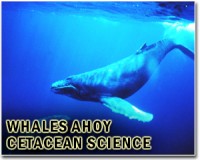| . |  |
. |
Cambridge, UK (SPX) Jun 30, 2009 We can only marvel at the way that dolphins, whales and porpoises scythe through water. Their finlike flippers seem perfectly adapted for maximum aquatic agility. However, no one had ever analysed how the animals' flippers interact with water; the hydrodynamic lift that they generate, the drag that they experience or their hydrodynamic efficiency. Laurens Howle and Paul Weber from Duke University teamed up with Mark Murray from the United States Naval Academy and Frank Fish from West Chester University, to find out more about the hydrodynamics of whale and dolphin flippers. They publish their finding that some dolphins' fins generate lift in the same way as delta wing aircraft in The Journal of Experimental Biology, Using Computer tomography scanning of the fins of seven different species ranging from the slow swimming Amazon River dolphin and pygmy sperm whale to the super-fast striped dolphin, the team made scaled models of the flippers of each species. Then they measured the lift and drag experienced by the flipper at inclinations ranging from -45deg. to +45deg. in a flow tunnel running at a speed that would have been the equivalent of 2m/s for the full scale fin. Comparing the lift and drag coefficients that the team calculated for each flipper at different inclination angles, they found that the flippers behave like modern engineered aerofoils. Defining the flippers' shapes as triangular, swept pointed or swept rounded, the team used computer simulations of the fluid flows around the flippers and found that sweptback flippers generate lift like modern delta wing aircraft. Calculating the flippers' efficiencies, the team found that the bottle nose dolphin's triangular flippers are the most efficient while the harbour porpoise and Atlantic white-sided dolphin's fins were the least efficient. Commenting that environmental and performance factors probably play a significant role in the evolution of dolphin and whale flipper shapes and their hydrodynamics, Howle and his colleagues are keen to find out more about the link between the flippers' performances and the environment that whales and dolphins negotiate on a daily basis. Share This Article With Planet Earth
Related Links The Company of Biologists Follow the Whaling Debate
 Whaling ban holds as conference ends in disarray
Whaling ban holds as conference ends in disarrayFunchal, Portugal (AFP) June 25, 2009 The International Whaling Commission's annual conference ended in disarray Thursday, keeping in place a ban on commercial whaling amid deep rifts between hunters and conservationists. The commission's new chairman said the IWC should now question its role as the conference on the Portuguese island of Madeira wrapped up a day early with delegates agreeing only to extend negotiations on whaling ... read more |
|
| The content herein, unless otherwise known to be public domain, are Copyright 1995-2009 - SpaceDaily. AFP and UPI Wire Stories are copyright Agence France-Presse and United Press International. ESA Portal Reports are copyright European Space Agency. All NASA sourced material is public domain. Additional copyrights may apply in whole or part to other bona fide parties. Advertising does not imply endorsement,agreement or approval of any opinions, statements or information provided by SpaceDaily on any Web page published or hosted by SpaceDaily. Privacy Statement |